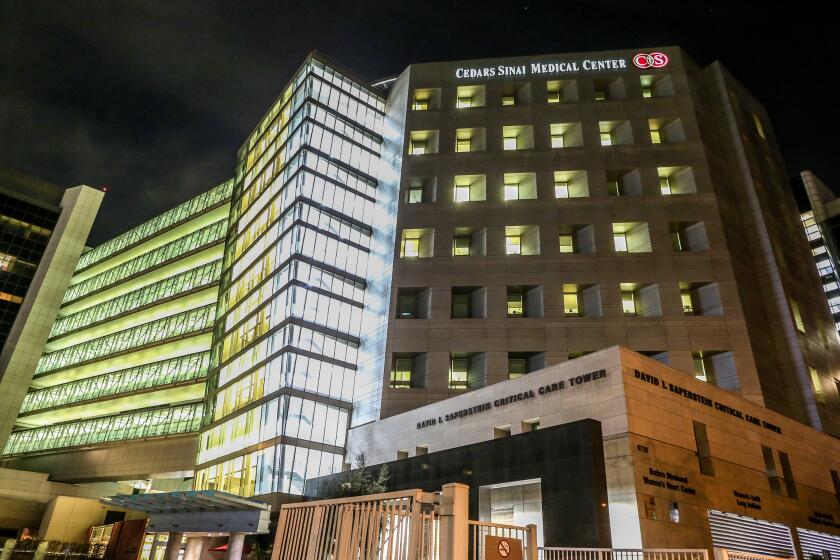A Picture-Perfect Day on Mars
In a spectacular success for NASA’s return to Mars after a 21-year absence, the Pathfinder spacecraft bounced safely off the rocky surface of the Red Planet at just after 10 a.m. on the Fourth of July and coasted to a halt right on target and--more astonishingly--right-side up.
The first color images from the spacecraft’s stereo camera revealed a mystical, otherworldly landscape of wind-blown pink sand, rugged fields of rocks and boulders, and off in the distance a beckoning rolling hillside that project scientist Matthew Golombek said “has the scientists salivating.”
The images--”a unique birthday gift” to the nation, according to camera team chief Peter Smith--were presented about 6:30 p.m. to an awe-struck audience of scientists and reporters at Pasadena’s Jet Propulsion Laboratory, which manages the mission.
“These are our eyes,” Smith said. “We are all on Mars.”
As soon as the small rover aboard the spacecraft rolls down the ramp to start exploring its new territory--probably sometime late today--NASA will have taken its first step toward answering perhaps the compelling question of humankind: Are we alone?
The mission marks the beginning of an ambitious invasion of Mars by NASA over the next decade or more to learn whether the fourth rock from the sun ever bloomed with living creatures--and if it did, were they anything like the folks at home?
Just as significant, it signals the debut of a risky but provocative new technology which--if successful with Pathfinder--could eventually make possible everything from flying formations of telescopes that can see Earthlike planets orbiting other stars to astronomical observatories on the moon.
Serendipity seemed to be on NASA’s side from the outset of what turned out to be truly a historic day.
By late afternoon, Pathfinder’s camera began transmitting the first pictures of the Martian surface since the Viking spacecraft’s images taken in 1976. Pathfinder’s initial scratchy black and white images showed a rough, barren landscape of rocks and boulders.
The sight of the six wheels of the little 22-pound rover Sojourner was as beautiful as a newborn baby to the engineers who de signed it and set it on its seven- month, 300-million mile journey in December. The boulder-strewn landscape--interrupted with high rocky mounds--is in the middle of Ares Vallis, a plain created during a huge flood billions of years ago when Mars’ now bone-dry surface flowed with running water and possibly teemed with microscopic life.
“What a birthday today!” said NASA chief Dan Goldin, adding that the picture-perfect mission reinstated the United States as “masters of our solar system.”
“What a way to celebrate the Fourth of July,” said Ed Stone, director of the Jet Propulsion Laboratory in Pasadena, who said the successful landing ushered in a “new era of Mars exploration.”
Vice President Al Gore phoned to offer “congratulations on doing an outstanding job,” and “happy Fourth of July. The whole country is very proud of what you’re doing.”
The picture-perfect landing had mission controllers pinching themselves, said flight director Robert Cook, and wondering, “Is this real?”
“I’m ecstatic,” said deputy project manager Brian Muirhead. “We are on the surface of Mars. This was way beyond our expectations.” The entire entry into the Martian atmosphere and landing on its surface, he said, was “absolutely perfect.”
The only glitch was that one of the air bags that protected the craft during its bouncing landing appeared to be draped over one of the solar panels. Although this setback didn’t appear to affect the eventual success of the mission, it did require a delay of the rover’s grand entrance onto Martian soil.
By late Friday night, just as Earth was setting on Mars, mission controllers had directed the Pathfinder to raise one of its petals, tucking the air bags neatly underneath, and roll out the front ramp for the rover’s descent.
New images expected today should be grander even than Friday’s stunning vistas because the camera, called Imager for Mars Pathfinder, or IMP, is due to stand up to its full 5 1/2-foot height. The early images were taken from an almost ground level position. IMP traveled to Mars with its supporting skeleton coiled up in a can. With that more human-like perspective, Pathfinder should have a much better idea of the distance--and therefore the size--of the jagged mounds and boulders seen in the distance.
Sojourner will also stand up to its full 1-foot height sometime today to begin analyzing the rocks “that hold the clues to the history of Mars,” said Golombek.
“We’re going to learn a great deal about ourselves and our solar system,” said flight director Richard Cook.
The success of the risky mission, said Goldin, was a fitting tribute to the revolutionary founders of our country who “weren’t afraid of taking risks” and “doing things differently.”
NASA has presented the Pathfinder mission as a high-risk road test of technology that will be used to explore the universe in new ways--using small, cheap, expendable spacecraft instead of expensive once-in-a-decade shots that risk everything on a single mission.
The well-behaved spacecraft apparently descended, deployed its parachute and retrorockets and landed with a precision that astonished JPL scientists. It even phoned home early, sending out a weak but comforting signal that prompted project director Tony Spear to dance a little jig in the flight control center.
“Believe me, we didn’t expect to see this stuff this soon,” said Muirhead. “This is nirvana.”
The signal was so weak, said Muirhead, that it was like “picking up a candle from 120 miles.”
The first 15-second pulse was sent out by the craft after its parachute deployed, but before its air bags opened to cushion its descent. A few minutes later, a second signal--sent out by a tiny antenna “no bigger than your thumb,” said Muirhead, told controllers that Pathfinder had not only landed--but was standing upright.
“I’ve got a grin that goes from ear to ear and it’s not going away,” Golombek said.
Goldin walked around the flight control center giving out hugs and congratulations like cigars. Mars program director Donna Shirley wiped tears from her eyes. “The signal told them the parachute worked, the heat shield worked, the air bags worked, it all worked,” she said.
Even better, the little spacecraft apparently landed on smooth ground; if it had landed in a rough spot or depression, the weak signal never would have made its way over the Martian horizon to Earth. Luckier still, it landed on its base--one of four “petals” in the pyramid-shaped craft. “What are the odds of that?” asked Rob Manning, chief flight engineer, joking that he was a little disappointed that the engineers didn’t get to try out the mechanisms they had built into the Pathfinder to flip it upright, in case it landed on one of its sides.
According to preliminary data taken during the landing, the air-bag-encased spacecraft bounced hard at least three times up to a height of about 50 feet. Mars had a few surprises in store, however. For example, when the rockets fired to slow the spacecraft during its descent, Pathfinder was traveling faster than expected--about 140 mph. The implication, said Manning, is that the atmosphere may be thinner than expected and “we don’t understand the atmosphere of Mars as well as we thought we did.”
The temperature on the surface was warmer than expected, Tim Schofield said, JPL team leader for the weather package. But he warned that it might not be an accurate reading because the weather mast carrying meteorological instruments had not yet been deployed, and the sensors might be picking up warmth from the spacecraft itself.
A very tired Golombek told a packed pressroom how he and colleagues had been frantically checking out the Martian terrain about 2 a.m.--fearful that the craft was about to land on the side of a rocky island that might have an unacceptably steep slope. They considered giving the craft a boost that might shove it off to one side--but all the other landing possibilities looked even more precarious than the one Pathfinder seemed to be headed for.
As it turned out, none of that was necessary. The craft landed in a field of small craters, etched in a herringbone pattern that seemed to suggest they were impacts created by matter ejected from a larger crater. That was good news for the geologists because the impacts might have dug underneath the surface to expose hidden minerals.
Like the first step on the moon, the first scratchy images from Pathfinder were a small step for the spacecraft, but a huge leap for NASA’s return to Mars after a 21-year absence. Over the next 10 years, 10 missions are planned that will scout the Martian landscape, collect rock samples and prepare for a human mission. Pathfinder was designed and launched before traces of possible ancient fossil life were found on a Martian meteorite last summer. However, that possible discovery has certainly added excitement to its technological success.
Although the spacecraft had safely survived its “wild ride,” Cook said, the mission controllers “are still in the middle of it.” Once the cameras send back images showing that it’s safe to unfurl the ramps for the rover, Sojourner will make its way down toward the Mars surface at the rate of a half an inch per second. Almost immediately, it will place its sophisticated “nose”--an alpha proton X-ray spectrometer--on the soil to analyze its composition.
The detector will not be able to look for signs of life--or even evidence of fossils. However, it will be able to deduce some thing about the environment and perhaps detect the past presence of water. Because water is perhaps the single most important ingredient for life, second to carbon, finding traces of water boosts the chances that the planet was once populated by living things.
Pathfinder’s primary task is to test the technology that will take NASA into the future. Mars Global Surveyor, another relatively low-cost spacecraft, is already on its way to Mars and will slip into orbit and begin mapping the planet in September. Then, in 1998, when the orbital paths of Mars and Earth bring them close together once more, another pair of spacecraft will head for the planet next door. One of them will carry tiny penetrators that dig into the Martian surface, looking for water.
Future missions might be able to dig even deeper. However, researchers believe that any current life on Mars--if it exists--must lie deep beneath the surface, shielded from the intense radiation and harsh chemistry that destroys all organic substances on Mars’ dry surface.






